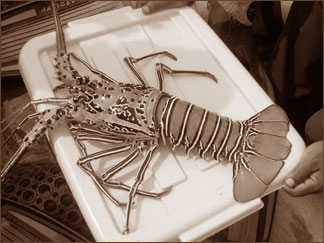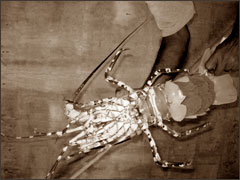Protecting aquatic resources from over exploitation
NARA to implement a sustainable solution:
By Harshini PERERA
Crystal blue waters on the surface conceal lobsters, chanks, prawns,
sea cucumbers and marine ornamental fish inside its body as if to
protect it from being hunted both by predators and humans alike.
Unfortunately man has reached a state which surpasses nature and further
gather the harvest in large quantity which nature has sown under the
sea. Thus the situation is about to lead to the extinction of these five
species. The Sunday Observer learnt that they are threatened due to the
over-consumption.
|

Lobster |
NARA (National Aquatic Resources Research and Development Agency)
tries hard to prevent the harm done to aquatic eco systems and the
fisheries industry. Dr. Champa Amarasiri, Director of Research in NARA
expressed her ideas; "These five species are highly export oriented and
are, therefore over-exploited in a bid to earn foreign exchange. Any
regulation imposed on the industry, such as a ban on fishing of these
species directly affect the socio-economical situation of the country
for a large number of fishermen are dependent on the industry.
Aromatic dishes of soup and western meals, made out of sea cucumber
and chanks in China, Hongkong, Singapore exported from Sri Lanka earn a
large sum of foreign exchange for Sri Lanka while it causes extinction
of such animals from the entire coastal belt. For they are slow moving,
oblivious to the fact that they become easy prey. Scuba divers are
expert in the enterprise because the species are inhabitants of deep
sea. Sea cucumber is boiled and dried before exportation whereas chanks
have a long history running up to the colonial period when they were
exported to produce bangles and other ornaments out of their shells.
Lobsters too are exported both live and dead and earn much foreign
exchange. Marine Ornamental fish, inhabitants of coral reefs beautify
homes of foreigners. They can be seen throughout the coastal belt and
fishing destroys coral reefs as well.
NARA has learnt if the situation continues unabated, the stock they
can harvest could decline as a consequence of over consumption.
Responsibility and dexterity of NARA comes into play at this point. The
"Fishery Resources Assessment Project" started in January 2008, of which
NARA is the implementing governmental body while two other foreign
bodies; Canadian International Development Agency (CIDA) and
International Fund for Agricultural Development (IFAD) spend US $ 2
million to make it effective. It is a co-management plan alias a
collaborative management plan which closely works and cooperates with
the stakeholder in each of its activities.
The primary stage of the project comprises an Under Water Assessment.
Dr. Amarasiri explained that the purpose of the survey is to understand
and calculate available bio mass as well as the total allowable catch
from each fishing ground. Progress of this assessment will reveal facts
on fishing grounds while facilitating to carry out an effective
management plan about the industry.The project is implemented in the
North West, the East and the South covering the areas of
Kalpitiya-Mannar, Vakarai-Sangamankanda and Kirinda. NARA has identified
that fishing of chanks, sea cucumber, prawns, marine ornamental fish and
lobsters are quite high in these areas and this in turn stands as a
threat to the industry. The fishermen, divers, suppliers function as
stakeholders in the project being responsible for sustainable
utilisation of resources. There is a kind of national need to protect
bio-diversity and protect the livelihood of fishermen besides the mere
implementation of the project. Two Australian foreign experts, Dr. Brin
Long, International Survey Biologist and Noel Tayler Moor, Fishery
Management Expert Food and Agriculture Organisation (FAO) are involved
in the project. The project helps in the capacity building of NARA staff
as well.
|

Lobster carring eggs |
The project is implemented in major landing sites where the number of
boats in use and the number of individuals in each species caught in
certain areas can be calculated.
Biological data of the species such as the reproductive period are
collected . For instance, reproductive organs of the sea cucumber are
collected to identify their reproductive patterns. Then action is taken
to lessen the number of catch particularly during the reproductive
period. Through these experiments NARA has learnt that certain species
are dominant only in certain areas, so a spatial difference in fishing
can clearly be seen.
Some species like lobsters fetch a high price in local market which
is the sole reason why fishermen try to catch lobsters to earn a
handsome income. Lobsters are inhabitants of hilly and rocky grounds at
the bottom of the sea. So fishermen use nets to catch them. They drag
their nets along the sea bed. This action of fishermen causes the
destruction of precious coral reefs and may destroy sea weeds which
supply food for the species. Similarly, immature prawns are being caught
for the price they fetch but the young generation capable of
reproduction is destroyed.
Under the project, an independent study on sea cucumber in the East
and the North West coasts is carried out. The purpose of this assessment
was to identify the total allowable catch of sea cucumber in these
areas. As a result of the assessment NARA has realised that a commercial
factor lies in the population density. Commercially valuable species
have become less dominant while commercially valueless species have
become dominant in fishing areas.
Sea Bed Mapping is the other assessment technique used in shrimp
fishing or prawn fishing. It helps NARA to manage the shrimp resources
by estimating the standing stocks and the total allowable catch in
existing fishing grounds. The area NARA covered ranged from Palangaturei
to Kudiramale.
In lobster fishery, Echo-sounders were used for sea bed mapping to
identify lobster habitats while a land survey was done to determine
existing fish resources and the number caught.
An Under Water Survey is being carried out to estimate the resources.
Lobster population has become difficult to trace since their habitats
are either rocky areas or are widely spread.
Samatha Gunasekara, Chief Preventive Officer of Sri Lanka Customs,
mentioned that regulations on lobster fishery came into effect from 1971
that requires the exporter to get a licence. He also mentioned that the
number of lobsters exportation has depleted.
The project though in its data analytical stage, is supposed to be
finalised by February 2009. Depending on the data NARA received,
suitable action will be taken to fight against the over exploitation or
over consumption of these species. Thus NARA will implement a
sustainable solution for these exploited species in the near future. |
